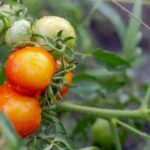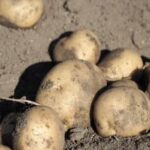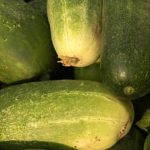The growing popularity of container gardening on Pinterest has brought about a renewed interest in cultivating fruits and vegetables in limited spaces. The platform’s vast array of inspiring images and ideas has sparked creativity among garden enthusiasts, leading to the rise of beautiful and productive container gardens. This article explores the world of Pinterest container gardening for fruits and vegetables, highlighting the benefits of this practice and providing valuable tips and techniques for success.
Container gardening offers numerous benefits when it comes to growing fruits and vegetables. One advantage is the flexibility it provides, allowing individuals with limited outdoor space or no backyard at all to still enjoy the pleasures of homegrown produce. Whether you have a small balcony, a sunny windowsill, or even just a few square feet on your patio, you can create a bountiful garden by utilizing different types of containers.
This article will guide you through the process of selecting the perfect containers for your crops, offering insights into various options such as pots, hanging baskets, and wooden boxes. It will also delve into considerations like size and depth to ensure your plants have ample room to thrive.
Additionally, we’ll explore essential tools, materials, soil mixtures suitable for container gardening, drainage systems, watering techniques, and fertilizers – both traditional options and organic alternatives. With these elements in place, your Pinterest container garden will be set up for success.
Selecting the Perfect Containers
Container gardening offers a versatile and convenient solution for individuals with limited space or those who want more control over their garden. When it comes to selecting the perfect containers for your fruits and vegetables, there are various options to consider.
One popular choice is pots, which come in a wide range of materials such as plastic, clay, or ceramic. They are available in different sizes, allowing you to choose one that suits the specific needs of your crops. Hanging baskets are another excellent choice for container gardening.
These can be hung from porches, fences, or hooks, maximizing the use of vertical space. Wooden boxes or crates are also commonly used for growing fruits and vegetables in containers. They offer a rustic aesthetic appeal and can be easily customized to fit your preferred size and shape.
When choosing the right container, it is crucial to consider the size and depth requirements of different crops. Larger plants such as tomato vines or citrus trees will require spacious containers with sufficient depth for their roots to grow deep and strong. On the other hand, smaller plants like herbs or lettuce can thrive in shallower containers.
To help you select your containers effectively, here is a list summarizing the various container options:
- Pots: Plastic, clay, or ceramic containers available in different sizes.
- Hanging baskets: Ideal for maximizing vertical space.
- Wooden boxes/crates: Customizable options with a rustic appeal.
Remember to take into account the size and depth considerations when selecting containers for certain crops. This will ensure that your fruits and vegetables have enough room to grow healthy and productive roots.
In addition to choosing appropriate containers, it’s essential to provide proper care for your plants by using suitable tools and materials. The next section will discuss the essential tools and materials needed for successful container gardening.
Essential Tools and Materials
Container gardening requires specific tools and materials to ensure the success of your plants. Having the right supplies not only makes the gardening process easier but also contributes to the overall health and productivity of your fruits and vegetables. In this section, we will explore the essential tools and materials needed for a thriving container garden.
One of the key elements in container gardening is choosing the appropriate soil mixture. Unlike traditional gardens, container plants rely solely on the soil within their containers for nutrients and water. It is essential to use a high-quality, well-draining soil mix that provides adequate nutrition to your plants. Many garden centers offer pre-packaged potting mixes specially formulated for container gardening.
Proper drainage is another crucial aspect of successful container gardening. Containers need to have drainage holes at the bottom to prevent water from accumulating and causing root rot. Additionally, it is beneficial to elevate your containers slightly off the ground using saucers or pot feet, allowing excess water to escape freely.
In terms of watering systems, there are several options available for container gardeners. One popular method is installing drip irrigation systems that deliver water directly to the plant’s roots without wasting water through evaporation or run-off. Another option is using self-watering containers or adding a reservoir system that allows plants to draw water as needed.
Fertilizers are vital for providing proper nutrition to your container plants. With limited space and resources, it is crucial to choose fertilizers that are specifically designed for container gardening. Slow-release fertilizers are commonly used in containers as they provide nutrients gradually over an extended period. Organic alternatives such as compost tea or worm castings can also be incorporated into your routine for more sustainable nutrient supplementation.
| Tools | Materials |
|---|---|
| Potting trowel | Potting mix |
| Hand pruners | Containers with drainage holes |
| Garden gloves | Saucers or pot feet |
| Drip irrigation system | Self-watering containers or reservoirs |
| Fertilizer applicator | Slow-release fertilizers or organic alternatives (compost tea, worm castings) |
Pinned for Success
When it comes to container gardening, certain fruits thrive exceptionally well in this environment. Whether you have limited outdoor space or simply want the convenience of having fresh fruits at your fingertips, these Pinterest-worthy fruits are perfect for container gardening.
Strawberry towers and hanging baskets
Strawberries are one of the most popular fruits for container gardening due to their compact size and delicious flavor. Create a stunning strawberry tower by stacking pots on top of each other, with each pot having multiple openings for planting strawberries. Hanging baskets are another great option for growing strawberries. Hang them in a sunny area and watch as your plants produce juicy berries that hang down beautifully from the baskets.
Blueberry bushes in pots
Blueberries can also thrive in containers, making them an excellent choice for any fruit lover. Choose a large pot with good drainage and fill it with an acidic soil mixture. Blueberry bushes prefer slightly acidic soil to properly absorb nutrients. With regular watering and proper care, your potted blueberry bushes will yield a sweet abundance of these nutritious berries.
Citrus trees in containers
For a taste of the tropics right in your own home, consider growing citrus trees in containers. Lemon, lime, and orange trees can all be successfully grown in pots as long as they receive enough sunlight and proper care. Pick a dwarf variety of citrus tree to ensure that it stays small enough to fit comfortably into a container and make sure to provide regular doses of citrus-specific fertilizer to promote healthy growth and fruit production.
By selecting these best fruits for container gardening, you can create beautiful arrangements that not only add visual appeal but also provide delicious homegrown fruits that can be enjoyed throughout the season. Experiment with different varieties and combinations to find what works best for your space and taste preferences.
To maximize success, remember to provide adequate sunlight, water consistently, and regularly fertilize your container plants. With a little bit of love and attention, you’ll be enjoying fresh fruits straight from your container garden in no time.
Pinterest-Worthy Vegetable Container Gardens
Container gardening is not only limited to beautiful flowers and herbs, but it also offers endless possibilities for growing your own vegetables right on your patio or balcony. With the help of Pinterest, you can create stunning and functional vegetable container gardens that will inspire both awe and envy. Here are some ideas to get you started on your Pinterest-worthy vegetable container garden.
Lettuce Bowls for Fresh Salads All Season Long
Lettuce is one of the easiest and most rewarding vegetables to grow in containers. Consider creating a lettuce bowl by selecting a wide, shallow container that can accommodate multiple varieties of lettuce. Fill the container with loose, well-draining soil, leaving enough space between plants for them to grow and thrive. As the weather warms up, you can move the container to a shadier spot to prevent lettuce from bolting.
To ensure a continuous harvest, opt for leafy lettuce varieties such as romaine or butterhead that will allow you to harvest leaves individually rather than harvesting the entire plant. Additionally, intersperse your lettuce bowl with colorful edible flowers like nasturtiums or pansies for an extra pop of color.
Vertical Tomato Gardens Utilizing Wall Space Efficiently
If you have limited floor space, vertical tomato gardens are the perfect solution to maximize your harvest. Using trellises or stakes, you can train tomato plants to grow vertically instead of sprawling on the ground. This not only saves space but also improves air circulation around the plants and reduces disease risks.
Choose determinate tomato varieties that tend to be more compact and produce fruit at once rather than continuously throughout the season. Plant them in large containers filled with moisture-retentive soil mixed with compost for optimal water retention and nutrients.
Compact Root Vegetables like Carrots and Radishes in Window Boxes
Window boxes are often underutilized when it comes to growing vegetables, but they can be a fantastic space for growing compact root vegetables like carrots and radishes. Opt for window boxes that are at least 6 inches deep to accommodate the root growth of these crops.
Fill the window box with a well-draining, loose soil mix that is rich in organic matter. Sow the seeds thinly according to the packet instructions, providing consistent moisture during germination and throughout their growth. As your carrots and radishes mature, thin them out to ensure proper spacing and avoid crowding.
By incorporating these vegetable container garden ideas into your Pinterest board, you can create a visually stunning and productive garden right at your fingertips. Get inspired by other gardening enthusiasts on Pinterest, share your successes, and continue to explore the endless possibilities of container gardening fruits and vegetables.
Tending to Your Container Garden
Your container garden requires regular care and attention to ensure healthy and productive plants. By following essential care tips, implementing pest control measures, and utilizing pruning techniques, you can maximize the success of your Pinterest-worthy container garden.
Essential Care Tips
Maintaining a healthy container garden starts with providing the basic necessities for your plants. Regular watering is crucial for the growth and productivity of fruits and vegetables in containers. Be sure to water your plants thoroughly, allowing excess water to drain out through drainage holes in your containers. Check the moisture level by sticking your finger into the soil; if it feels dry an inch below the surface, it’s time to water again.
In addition to watering, proper nutrition is vital for strong and vibrant plants. Consider using slow-release fertilizers or organic alternatives such as compost or worm castings to provide a steady supply of nutrients throughout the growing season. Follow package instructions on how much fertilizer to use based on the size and type of container you are using.
Pest Control Measures
Container gardens are not immune to pests, but by taking proactive steps, you can minimize their impact on your plants. Inspect your plants regularly for signs of pests such as aphids, caterpillars, or spider mites. If you notice any pests, take appropriate action immediately.
One effective method is handpicking insects off your plants or spraying them with a mixture of water and dish soap. Alternatively, you can use organic pest control solutions like neem oil or insecticidal soaps specifically formulated for use on edible crops.
Pruning Techniques
Pruning plays a crucial role in maintaining the health and productivity of your container garden. Regularly inspect your plants for any dead or yellowing leaves and remove them promptly to prevent the spread of diseases. Prune overcrowded branches to improve air circulation and sunlight penetration within the plant.
For vining plants such as tomatoes or cucumbers, prune suckers, which are the small shoots that grow between the main stem and branches. This allows the plant to direct its energy towards fruit production rather than excessive foliage growth.
Designing a Pinterest-Worthy Container Garden
When it comes to container gardening, the possibilities for creating a visually stunning and Pinterest-worthy garden are endless. Designing a beautiful container garden not only adds aesthetic appeal to your space but also enhances the overall experience of growing your own fruits and vegetables. Here are some tips and ideas for designing a stunning container garden that will inspire others on Pinterest.
One way to create an aesthetically pleasing container garden is to experiment with creative and unique container arrangements. Consider mixing different types of containers such as pots, hanging baskets, and wooden boxes for added visual interest. Grouping containers of varying heights and sizes together can also create a dynamic display. Additionally, you can use unconventional items like repurposed vintage containers or colorful planters to add personality to your garden.
Incorporating companion plants into your container garden can also enhance its beauty while promoting healthy growth. Companion planting involves growing different plants together that benefit each other in various ways. For example, planting marigolds alongside tomatoes not only adds pops of vibrant color but also helps deter pests like aphids. Herbs like basil or parsley can be grown alongside many fruits and vegetables, adding both fragrance and flavor to your dishes.
To add a personal touch to your container garden, consider DIY container labels. Not only do labels help keep track of what’s planted where, but they can also serve as decorative elements in their own right. Get creative by using paint or markers on stones or wooden sticks to make personalized plant labels. You can even take it a step further by incorporating hand-lettering or using recycled materials like wine corks for a unique touch.
By focusing on design elements like container arrangements, companion planting, and DIY labeling, you can create a truly Pinterest-worthy container garden that will inspire others in their gardening endeavors. So let your creativity soar and start designing the perfect container garden that showcases both beauty and productivity in even the smallest of spaces.
Harvesting and Enjoying the Fruits of Your Labor
Harvesting and enjoying the fruits and vegetables from your container garden is one of the most rewarding parts of the process. Not only do you get to savor the flavors of your hard work, but you also have the satisfaction of knowing that you can create delicious meals with your homegrown produce. This section will provide some tips on when and how to harvest, as well as ideas for using your fresh harvests in recipes.
Knowing when to harvest different fruits and vegetables is crucial for optimal flavor and texture. Here are some general guidelines for common crops:
- Strawberries: Pick strawberries when they are fully red, firm, and fragrant. The best time to harvest is in the morning after the dew has dried off.
- Blueberries: Harvest blueberries when they have turned a dark blue color and easily come off the bush with a gentle tug.
- Lettuce: For leaf lettuce varieties, you can start harvesting individual leaves as soon as they reach a desirable size. For head lettuce varieties, wait until the heads are firm before cutting them at the base.
Once you’ve harvested your fresh produce, it’s time to put it to use in delicious recipes. Here are a few ideas:
- Strawberry shortcake: Use freshly picked strawberries to top a homemade biscuit or sponge cake, along with whipped cream for a classic summer dessert.
- Blueberry pancakes: Fold fresh blueberries into pancake batter for a burst of sweetness in every bite.
- Salad greens with vinaigrette: Toss freshly harvested lettuce leaves with your favorite vinaigrette dressing for a light and refreshing salad.
In addition to enjoying your harvest right away, there are also ways to preserve excess produce for future use. Freezing fruits like berries or blanching and freezing vegetables can help extend their shelf life so you can enjoy them throughout the year.
| Fruit/Vegetable | Harvesting Guidelines | Recipe Ideas |
|---|---|---|
| Strawberries | Pick when fully red, firm, and fragrant. Harvest in the morning. | Strawberry shortcake |
| Blueberries | Harvest when dark blue and easily come off the bush with a gentle tug. | Blueberry pancakes |
| Lettuce | For leaf lettuce, harvest individual leaves as they reach desired size. For head lettuce, wait until heads are firm before cutting at the base. | Salad greens with vinaigrette |
Share Your Success on Pinterest
Pinterest has become an incredibly popular platform for sharing ideas and inspiration, and container gardening is no exception. With its visually appealing format and endless array of photos and posts, Pinterest has become a go-to resource for those looking to showcase their container gardening success.
Whether you’re a seasoned gardener or just starting out, sharing your achievements on Pinterest can not only provide a sense of pride and accomplishment but also inspire others to embark on their own container gardening journey.
One way to share your success on Pinterest is by posting pictures of your container garden. Whether it’s a lush strawberry tower overflowing with juicy berries or a vibrant lettuce bowl filled with fresh salad greens, capturing the beauty of your plants in photographs allows you to document your progress and share it with others. Plus, seeing the visual representation of your hard work can be incredibly rewarding.
In addition to posting pictures, joining online gardening communities on Pinterest can connect you with like-minded individuals who share similar interests. These communities often provide valuable tips and advice for successful container gardening, allowing you to learn from others’ experiences and expand your knowledge. It’s also a great way to ask questions, troubleshoot issues, and engage in conversations about all things related to container gardening.
By sharing your success on Pinterest, you have the opportunity to inspire others to start their own container gardens. Seeing what’s possible in terms of creativity and productivity in a small space can motivate others to take action and grow their own fruits and vegetables. Furthermore, by highlighting the benefits of container gardening such as accessibility and convenience, you can encourage more people to embrace this sustainable practice and contribute towards healthier living.
Conclusion
In conclusion, container gardening for fruits and vegetables has become increasingly popular on Pinterest for good reason. Not only does it allow individuals with limited space to engage in gardening, but it also offers numerous benefits such as convenience, versatility, and the ability to control soil conditions. By selecting the perfect containers, utilizing essential tools and materials, and exploring various fruit and vegetable options, anyone can create a flourishing container garden.
Tending to a container garden requires some care and attention, but the rewards are well worth it. With proper maintenance techniques such as regular watering, pest control measures, and pruning strategies, your plants will thrive and produce bountiful harvests. Additionally, designing an aesthetically pleasing container arrangement can enhance your gardening experience and spark inspiration throughout the growing season.
The joy and satisfaction of Pinterest container gardening extend beyond just the act of growing fruits and vegetables. It is a journey of discovery, creativity, and productivity that allows you to take control of your food supply while expressing your personal style. So why not start today?
Whether you have a balcony or a windowsill, there are limitless possibilities for growing delicious produce in containers. Share your success online, join gardening communities for support and inspiration, and inspire others to embark on their own Pinterest container gardening journey. Happy planting.
Frequently Asked Questions
What are the best vegetables and fruits to grow in containers?
The best vegetables and fruits to grow in containers are ones that don’t require a lot of space to thrive. Some popular choices include tomatoes, peppers, lettuce, spinach, radishes, and carrots. These plants have shallow roots and compact growth habits, making them ideal for container gardening.
Additionally, fruits like strawberries and blueberries can also be grown in containers successfully. It’s important to choose varieties that are well-suited for container gardening to ensure successful and productive growth.
What vegetables grow well together in a container?
When it comes to growing vegetables together in a container, it’s crucial to consider their compatibility in terms of sunlight requirements, water needs, and root depth. A good example of companion planting in containers is combining tomatoes with basil or marigolds.
Tomatoes benefit from the aromatic herbs as they deter pests like aphids, while basil or marigolds can get some shade from the tomato plants. Other compatible combinations include lettuce with radishes or carrots since they have similar sunlight and watering needs.
How do you arrange a vegetable garden container?
Arranging a vegetable garden container requires thoughtful planning to optimize space and maximize productivity. Start by selecting containers that provide enough room for the chosen vegetables’ root systems. Place taller plants towards the center or back of the container to prevent shading smaller ones excessively. Consider vertical gardening techniques for vining crops like beans or cucumbers as they will save space while encouraging upward growth.
Avoid overcrowding by following recommended spacing guidelines for each plant variety. Also, incorporating trellises or stakes can help support climbing plants and prevent damage caused by wind or heavy fruiting stems. Finally, remember to position your containers in an area that receives adequate sunlight throughout the day for optimal plant growth and development.

If you’re looking to get into vegetable gardening, or are just looking for some tips on how to make your current garden better, then you’ve come to the right place! My name is Ethel and I have been gardening for years. In this blog, I’m going to share with you some of my best tips on how to create a successful vegetable garden.





